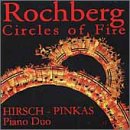| All Artists: George Rochberg, Hirsch-Pinkas Piano Duo Title: George Rochberg: Circles of Fire Members Wishing: 0 Total Copies: 0 Label: Gasparo Records Original Release Date: 1/1/1996 Re-Release Date: 12/19/2000 Genre: Classical Styles: Chamber Music, Historical Periods, Classical (c.1770-1830) Number of Discs: 1 SwapaCD Credits: 1 UPC: 755101034323 |
Search - George Rochberg, Hirsch-Pinkas Piano Duo :: George Rochberg: Circles of Fire
 | George Rochberg, Hirsch-Pinkas Piano Duo George Rochberg: Circles of Fire Genre: Classical
|
Larger Image |
CD Details |
CD ReviewsAn important statement and a moving testimony Discophage | France | 12/17/2009 (5 out of 5 stars) "George Rochberg's Circles of Fire for two pianos is an important and superb composition, in some ways reminiscent of Messiaen's Visions de l'Amen, and not only by dint of its same instrumental ensemble.
It was written in 1996-97 for the Hirsch-Pinkas piano duo (made of husband and wife Evan Hirsch and Sally Pinkas) who plays it here. It is then a late work in Rochberg's output, and a summation of his compositional style(s). It doesn't have the stylistic unity and uniqueness of Messiaen's Visions de l'Amen or Crumb's Makrokosmos III & IV. On the contrary, it is very "polystylistic". It has the haunting and mysterious stellar vistas of Messiaen (I Solemn Refrain 1 and its symmetrical XV Solemn Refrain 5, or VII Nebulae), slow-moving and enigmatically atmospheric statements in dissonant chordal progressions, with occasional, craggy and brutal outbursts of sound evocative of the post-Scriabin "mystic" composers like Rudhyar or Ruggles or Wyshnegradsky without the quarter tones (II Chiaroscuro 1 and its symmetrical XIV Chiaroscuro 2), moments of subtle and delicate twelve-tone writing reminiscent of Schoenberg and Autro-German expressionism (III Canonic Variations, the slow sections of XII Caprichos); there's the dazzling and hammering virtuosity of IV Gioco del Fuoco, VI Gargoyles or XII Caprichos (the latter titled after Goya's late drawings showing the horrors of human behavior and soul) which, in their obsessive ostinatos and pounding syncopations, could be a cross-breed of Antheil and Bartok gone insane. Gargoyles even alternates those aggressive, scherzando passages with surprising, delicate ripples straight out of Debussy (and some of that too in VII Nebulae, as well as in the chordal progressions of VIII-Solemn Refrain 3). There is also a flirt with the "post-modern" in IX - Sognando (dreaming), in which Rochberg quotes and elaborates at length (the movement is one of the longest in the cycle, running 11:30) on two themes from the slow movement of Brahms' First Clarinet Sonata and his Intermezzo for piano opus 118/4. Despite the sweetly lulling feeling elicited by the movement, I do have qualms about the effectiveness of this quotation-craze so typical of many contemporary composers. Other than in some Schnittke compositions (and in the Bach inspirations that have so insipred 20th Century music), I find that it simply doesn't work: it is stylistically jarring, as some "odd-piece out" in a stylistic universe in which it doesn't chime. Maybe it is because Rochberg hasn't elaborated and transformed these themes enough, making them fully his own. And why does he drag the movement for so long, playing those already slow-moving themes at about twice the tempo, I don't know: probably to evoke not so much Brahms as the dream of Brahms. After his violent and angered rejection of serialism in 1964, Rochberg did away with any notion of "progress" or "evolution" in the history of music. As he writes in the introduction to the liner notes: "what is beautiful knows no temporal boundaries, recognizes no cultural moment as more special than any other. In much the same spiritwe can now think of the past as present, tonal music having no more special rights than atonal music - so long as both attain the condition of the beautiful". Still, memory (the composer's as well as the listener's) does inform the way we listen to music, and makes it in my opinion impossible to simply quote music of the past - even at twice the tempo. Write the most beautiful Mozart or Brahms Symphony today, and it'll be NOT a beautiful Mozart or Brahms Symphony, but, at best, a good pastiche. The whole subsequent history and evolution of music has flown by and it is the whole of that history that a composer is heir to and has to conjure in his compositions. The same comments could be applied to the visual arts. I am more convinced by the neo-Bach elaborations in X The Infinite Ricercar and XIII Fuga a Sei Voci. The Infinite Ricercar is quite original in its conception, an ominous four-voice canon that goes endless circles until the performers, when they feel they have reached the point of saturation of the audience's attention, are instructed to "simply fade out". The Fuga is equally impressive: in it Rochberg superimposes the straight and inverted themes from Bach's Contrapuntus XIII in The Art of Fugue, at a fast tempo and soft dynamics, and peppered with numerous trills. It sounds like Bach heard in wild gushes of wind. From these comments you may infer that Circles of Fire is somewhat derivative, and to some extent it is, but that to my ears doesn't diminish its appeal and significance. Excellent liner notes, with detailed description of the movements by pianist Evan Hirsch, TT 70+ minutes. Despite my reservations about the Brahms quotations, this is an important statement and a moving testimony. The "Circles of Fire" of the title are, to make it short, those of the creative imagination, deriving from and mirroring, in Rochberg's own words, "the universal fire that makes solar systems and galaxies, asteroid belts and comets, huge orbiting spirals, circles, loops that bend back on themeselves in giant symmetries and stream out across millions of miles in giant asymmetrie", and "music is the perfect expression of this utterly fantastic image". " |

 Track Listings (15) - Disc #1
Track Listings (15) - Disc #1